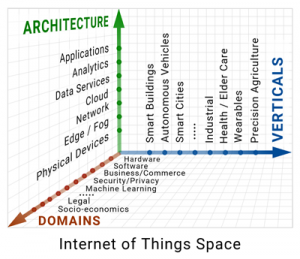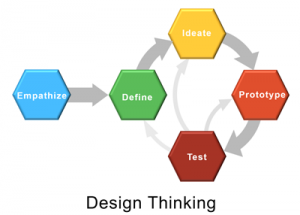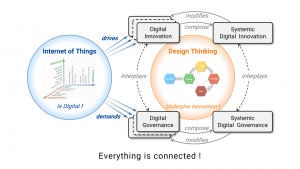By Walter Knitl and Nilufer Erdebil
We live in a digital world, immersed in digital information not just generated by humans but also by the pervasive Internet of Things (IoT). The IoT is an extension of the Internet, which now interconnects things, humans, and applications.
While on the one hand, IoT drives innovation, creates economic value, and improves quality of life, it also, on the other hand, introduces challenges such as privacy, security, and diminishing human agency. This demands digital governance, simultaneously involving multiple economic and societal areas and consequently compelling a systemic governance approach.
Systemic digital governance requires that we more widely understand citizens and their needs, and uncover diverse solutions – leveraging the strengths of the Design Thinking process and mindset.
IoT – A Systemic Digital Innovation Driver 
The Internet of Things is not any single technology, economic sector, or use case. It is a paradigm with connected physical devices at its inception but extended to envelope much of the overall digital realm. When we talk about IoT, we arealso talking about digital. The IoT space encompasses architectural components such as devices, communication networks, and cloud; vertical digital solutions such as connected transportation, smart buildings and wearables; and a variety of domains or disciplines such as artificial intelligence, cybersecurity, privacy, and others.
Due to its breadth, IoT is a natural driver of digital innovation in the above and other individual areas. Moreover, IoT is a poster child for Systemic Innovation. NESTA defines Systemic Innovationas an interconnected set of innovations, where each influences the other, with innovation both in parts of the system and in the ways in which they interconnect. Systemic innovation manifests itself in IoT in at least two ways.
- Systemic innovation between parts of the IoT space itself
- Systemic innovation across (or between) the IoT space and the social space
An example of systemic innovation within the IoT space includes advancements in sensor technologies that enable scale and diversity of real-world sensing points, which then spur innovation in networks and communications (e.g., 5G, LoRaWAN) to deal with that scale. They also drive innovation in analytics and machine learning to extract insights from the mass of generated data. Or, conversely, machine learning algorithm advancements in the cloud drive microelectronics innovation to space-reduce and cost-reduce machine-learning-purposed compute engines. This then enables inexpensive machine learning at the edge or device level, fostering new generations of applications.
An example of systemic innovation across IoT and social realms includes the case of IoT providing the ability to monitor one’s own electrical energy consumption and production, involving domestic solar panels, electric vehicles, and household appliances. This changes human energy consumption behaviour that can also benefit the electric utility, other vested organizations, or society at large, motivating them to provide rewards to reinforce the IoT-facilitated behaviour. Such reward systems, in turn, create a need for secure transactions and contracts among people and organizations, driving Blockchain innovation (for example). These, in turn, drive technological innovation back into the IoT space to robustly identify and track devices. There are many such cross-realm examples of systemic innovation, not the least of which involve the cybersecurity and privacy risks presented by IoT. These demand social innovation and regulation to deal with it, consequently driving mitigating technology innovations back into the IoT space.
Design Thinking for Innovation 
The word “innovation” is easily thrown around and studied, but to actually become innovative is more challenging. Organizations often don’t know how to innovate or where to begin. Fortunately, Design Thinking provides an innovation mindset and a method for innovating. Design Thinking is, in general, a tool for uncovering end-users’ or clients’ real problems and for exploring possible diverse solutions. In our context, it’s not just applicable to individual innovation areas such as AI or cybersecurity, but it’s also critical for effecting and leveraging systemic innovation.
Systemic innovation not only amplifies the diversity of needs, expectations, and perspectives but also introduces the need to deal with cohesion between different identifiable areas. Design Thinking is especially suited to deal with this expanded diversity, cohesion, and the permutations of solutions. It helps to expose possibilities and to converge on the optimum systemic solution, the commonalities across constituent areas, and any specializations within.
Digital Governance
Innovation and new technologies have historically given diagonal (parallel but delayed) rise to new policies and often entire governance models. And for good reasons – to accelerate and scale use, and to mitigate negative effects. It’s no different today. The exponential digitalization of everything is demanding Digital Governance – with IoT as a main culprit.
While Digital Governance is now a serious objective, under which umbrella important work is done globally, it is a broad and still a bit foggy term. Does it mean governing and managing the digital data? Is it the governing of people that use digital? Or, is it governing jurisdictions using digital? Irrespective of the specifics, the overarching rationale is to address the interplay between digital technological structures and social structures, to both foster digital use and mitigate the negative impacts.
As each new digital technology emerges, work on new governance and policies is spawned for that technology silo. For example, 5G demands new telecommunications and spectrum policies; AI is spawning ethical AI standards; Cryptocurrencies and Blockchain are also creating the need for regulation; and so on. Design Thinking aids in innovating and developing the governance models and policies both within the silos and in between. The collaborative and co-creative nature of the methodology allows for open development of inclusive digital governance.
Systemic Digital Governance
 Governance based on technological or sectoral silos may be organizationally convenient, but just like siloed technological innovation, doesn’t leverage the benefits of a systemic approach.
Governance based on technological or sectoral silos may be organizationally convenient, but just like siloed technological innovation, doesn’t leverage the benefits of a systemic approach.
Since everything is digital today, and “the digital” crosses technological, sectoral, and societal boundaries, especially in the case of IoT, digital governance requires a systems and integrative thinking approach. Like systemic innovation, systemic digital governance is a path to best overall policies.
Knowledge of IoT is essential for the best outcomes of systemic digital governance innovation, as it exposes the breadth and interconnectedness of needs and issues across a wide range of areas. Design Thinking naturally fosters the systemic approach, especially in the empathize and define stages of the process, helping to consider a variety of viewpoints. As in the case of systemic digital innovation, Design Thinking has a central role in the development of systemic digital governance.
Digital literacy in the intrinsically broad IoT space, aided by Design Thinking, enables policymakers to see the big digital picture, serving to inform and facilitate their policies and underpin the systemic governance approach. This is the case even if they are accountable for specific individual technologies or sectors, such as:
- Connected transportation and mobility
- Industrial and advanced manufacturing
- Smart buildings and facilities
- Health and elderly care
- Precision agriculture
- Physical safety and security
- Smart energy and smart grid
- Circular economy and environmental sustainability
- Artificial Intelligence and Machine Learning
- Wireless and mobile telecommunications
- Edge and fog computing
- other
Conclusion
Every Thing and everything is connected– whether it’s the IoT connecting Things, people, and applications, or the interconnectedness among the IoT paradigm, Digital Innovation, Digital Governance, and Design Thinking.
The Internet of Things occupies a wide swath of the digital space intrinsically driving systemic digital innovation and compelling systemic digital governance. To innovate and develop effective systemic digital governance, a baseline level of digital literacy is needed for every public servant, including technological intuition among public-sector executives and policymakers. IoT must be a big part of that, given its breadth, pervasiveness and impact. As governance is about meeting the needs of citizens, it’s important to empathize and uncover their real and diverse problems and requirements. This is where Design Thinking steps in – to support achieving digital literacy and inclusive systemic digital governance innovation.
| Enroll in the September 26-27 workshop Digital Literacy Through Internet of Things and Design Thinking. |
About the Authors:Walter Knitl – CEO at Praxiem, Chief Business Development Officer at IoT613 Walter is CEO at Praxiem, empowering organizations to discover and deliver the right product to market, leveraging his extensive technology Product Management and Product Development experience. He is also a co-founder at IoT613, enabling the IoT community to learn, interact, and connect, including at the IoT613 Conference. Nilufer Erdebil – CEO at Spring2 Innovation Nilufer is the award-winning founder of Spring2Innovation and a leading innovation and design thinking consultant experienced in telecommunications, application development, project management & information technology management. Her firm focuses on strategy and vision development, design thinking, creating and managing innovation programs, and change management. |